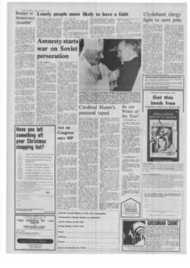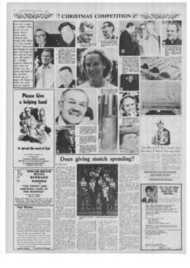Page 6, 1st December 1978
Page 6

Report an error
Noticed an error on this page?If you've noticed an error in this article please click here to report it.
Tags
Share
Related articles
Tamil Was 10 Years Old, A Bright, Cheerful Asian Child
The Hope That Hangs By
The Leper: Dragging Himself Along The Ground Or Standing...
The Hope That Hangs By
The Hope That Hangs By
1 1 Just one of Christ's
little ones saved from leprosy
by Fr. William Burridge, W.F.
. . . but for some, help came too late
TAMIL was 10 years old, a bright, cheerful Asian child in South India. Hut her parents began to notice the tell-tale marks of leprosy appearing on her skin. Their decision was quickly taken. It was too dangerous, too demeaning to have, as they cruelly put it, a leper in the family. So Tamil was abandoned to a life of destitution.
Homeless, shunned by the neighbours, alone. she wandered off, tiny as she was, to find an aunt she remembered some 20 miles away.
It was no joy to her aunt to find this stricken child in her doorway. But she could use her for chores about her dwelling. her bit of land and her few animals.
Tamil at least had food and shelter. But she had no love.
Psychologically disturbed by the trauma of her childhood, she grew up a wild creature. She had already developed the appalling ulcers from leprosy on her feet when the Sisters, travelling far from their post, discovered her.
They did what they could. They gave her special slippers to protect her feet, but her aunt sold them. Soon the bones were attacked. At last the Sisters succeeded in having her brought the long journey to their hospital. There was nothing for it by then but to amputate her leg.
She still dragged herself round to do the chores at her aunt's bidding. If ever the aunt grew tired of havihg her around, it would be a life of destitution again for Tamil, now a leporous, crippled girl of 17.
If only the Sisters had had the means and the support to expand their leprosy work years before, and had found that little child and so been able to halt the beginnings of her leprosy, Tamil would be today sound in mind and limb.
There are, thank God, many regions in Asian and African countries where leprosy work has expanded to reach out to victims far and wide.
A recent report describes one such stretch of country, 100 miles long by about 50 miles wide, in Eastern Africa.
Here leprosy work began as always with a centre where the
missionaries gave what comfort they could to a dozen or so victims with bodies already ruined by advanced leprosy. A modest hospital followed.
As the years went by clinical, surgical and even rehabilitation work and preventive medicine developed. Suitable trainees were recruited locally and with this extra assistant staff of dressers, porters and so on, the missionaries were able to go further and further afield in search of the victims.
In this case, 70 clinics have been set up across the 5,000 square miles or so, Down the scorching roads and along the bush path's Sister Doctor and her team go to visit the people at as many of the places as possible.
A makeshift shelter with a grass roof to keep out the sun. though not a downpour of ,rain, has been put up ready for her. Here she can see one by one the crowd of sufferers come in from the clusters of dwellings near and far, already gathered awaiting her arrival.
Nearby those already in the rehabilitation stage of treatment are being seen by an assistant. He looks for any muscular weakness and examines hands and feet for ulcers and burns -leprosy destroys sensitivity to fire and wounds, so that horrible accidents often result. And besides. deformed feet may need newly adapted sandals. artificial limbs may need alteration or replacement.
A controlling assistant is acting as receptionist for Sister Doctor. sorting out the waiting crowd, finding out whether medicines are being properly used. He also meets the local chiefs who will almost certainly call. Under a tree yet another group has gathered where a Sister and her assistants see patients suffering from all kinds of other ailments.
The 52 weeks of the year are all too short for these long days of heavy work, spent systematically moving right out to the periphery of this huge catchment area. The annual roll of people examined for leprosy mounts steadily in its thousands.
And meantime there is the work to he carried on at the Centre. because many leprosy sufferers still have to be brought in there, especially for surgery to remove fingers and limbs destroyed by the disease.
There are the "back up" undertakings. like talks to schools and trainee teachers, eiplaining all about leprosy, the need to come forward for help. the kind of treatment the leprosy unit can give: and there arc the local agricultural projects fostered by the unit to ensure fresh food for those in the many stages of leprosy care.
Typewritten reports from the missionaries engaged in leprosy work often read like matter-offact technical and statistical surveys. albeit showing admirable advance.
How different the warmth of the real human scene. in which it is all taking place and the transformation of the deep, newfound happiness in response to the quiet, attentive care: lifted from the state of the outcast to the joy and dignity of being loved and wanted: or finding a refuge from the terrifying fear at awareness of the first signs of the inroads of leprosy.
Across the front of one technical report. someone has written: "He has sent me to bring good news to the poor, to heal the nrokenhe irted, to give freedom to the downtrodden'.
How well that fits the neverending struggle against leprosy and how it unites in a single motive and ideal you who give your support to our leprosy work. and those who spend themselves in the field.
Through you. they bring love to the old and incurable and to the young, with their lives before them. freedom from the spectre of leprosy and a hope such as the little child Tamil never knew.
blog comments powered by Disqus















